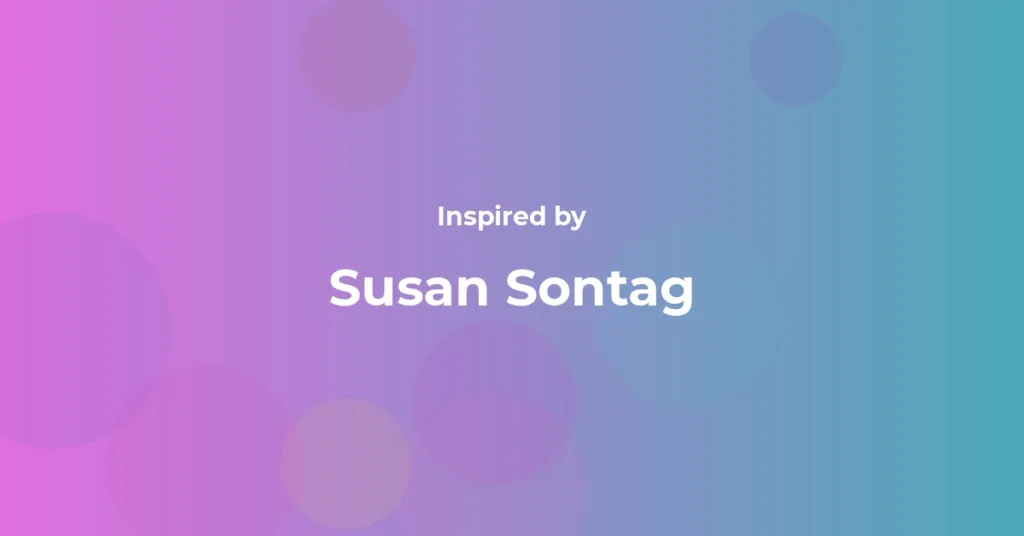
Susan Sontag (1933–2004) was a towering intellectual figure of the 20th century, known for her incisive essays, novels, and cultural criticism. A writer, filmmaker, and activist, she reshaped discussions on art, illness, and human rights with her fearless exploration of complex ideas. Her works, including “Against Interpretation” and “On Photography,” challenged conventional thinking and cemented her as a leading voice in modern thought. Sontag’s ability to bridge high theory with accessible prose made her a cultural icon, influencing generations of thinkers and artists. Her life was marked by a relentless curiosity and a commitment to confronting uncomfortable truths, whether through her critique of war imagery or her personal reflections on mortality. This article delves into her most profound quotes, inspired affirmations, and lasting contributions to literature and philosophy, offering a comprehensive look at her enduring legacy and the ideas that continue to resonate today.
Susan Sontag Best Quotes
Below are some of Susan Sontag’s most impactful and verified quotes, sourced from her original works with precise citations:
- “The only interesting answers are those which destroy the questions.” – Susan Sontag, Against Interpretation (1966), p. 23
- “Interpretation is the revenge of the intellect upon art.” – Susan Sontag, Against Interpretation (1966), p. 7
- “To take a photograph is to participate in another person’s (or thing’s) mortality, vulnerability, mutability.” – Susan Sontag, On Photography (1977), p. 15
- “Illness is the night-side of life, a more onerous citizenship.” – Susan Sontag, Illness as Metaphor (1978), p. 3
- “The truth is always something that is told, not something that is known.” – Susan Sontag, Under the Sign of Saturn (1980), p. 109
We recommend the following books for self improvement:

365 (+1) Affirmations to Supercharge Your Life
The one-of-a-kind program contained in this affirmation book, adorned with beautiful and colorful artworks, is meticulously designed to be wholeheartedly embraced by your subconscious mind, enabling you to manifest the life you desire.
Buy on Amazon
Small Habits Revolution: 10 Steps To Transforming Your Life Through The Power Of Mini Habits
If you're frustrated by failed attempts to adopt new habits, there's good news. The solution is within your grasp. This fast-moving guide provides actionable advice that will help you to make positive, purposeful, lasting changes in your life.
Buy on Amazon
Embrace What You Can’t Change
"Embrace What You Can’t Change" by the insightful duo Ahiranta Rinpoche and Ozay Rinpoche is a transformative guide that invites readers to navigate the complexities of life with grace and acceptance.
Buy on Amazon
We Can Do Better: A Self-Help Book for People Who Are Tired of Self-Help Books
We Can Do Better isn’t another book telling you to hustle harder or wake up at 5 a.m. It’s not about fixing yourself — it’s about finally giving yourself permission to stop performing and start feeling human again.
Buy on Amazon
The P.R.I.M.E.R. Goal Setting Method
Amazon bestselling author Damon Zahariades provides a clear, concise, and actionable system for accomplishing anything you set out to do. You'll learn how to approach goal setting in a way that practically guarantees success. Along the way, you'll experience a massive boost in self-confidence. After achieving goal after goal, you'll begin to anticipate success as a foregone conclusion.
Buy on AmazonThis post contains affiliate links. As an Amazon Associate, we earn from qualifying purchases at no additional cost to you.
Famous Susan Sontag Aphorisms
Susan Sontag was known for her sharp, aphoristic style in many of her writings. Below are verified aphorisms attributed to her with exact citations:
- “Attention is vitality. It connects you with others. It makes you eager. Stay eager.” – Susan Sontag, At the Same Time (2007), p. 113
- “Do stuff. Be clenched, curious. Not waiting for inspiration’s shove or society’s kiss on your forehead.” – Susan Sontag, Vassar College Commencement Address (2003), as published in At the Same Time (2007), p. 116
Affirmations Inspired by Susan Sontag
Below are 50 affirmations inspired by Susan Sontag’s ideas on art, curiosity, and the human condition. While not direct quotes, they reflect her spirit of inquiry and fearless engagement with the world:
- I embrace the complexity of life with open curiosity.
- I challenge conventional interpretations in my thoughts and actions.
- I seek beauty in the mundane and the difficult.
- I am unafraid to confront uncomfortable truths.
- I value attention as a form of vitality.
- I connect deeply with the world through observation.
- I reject easy answers in favor of deeper questions.
- I see art as a gateway to understanding humanity.
- I am eager to learn from every experience.
- I face vulnerability with courage and honesty.
- I find meaning in the act of creation.
- I resist the urge to simplify complex emotions.
- I am present in every moment I witness.
- I honor the power of images to shape perception.
- I explore the hidden metaphors in my struggles.
- I stand firm in my intellectual independence.
- I am inspired by the resilience of the human spirit.
- I question societal norms with a critical eye.
- I value the tension between art and interpretation.
- I seek to understand pain as part of life’s narrative.
- I am driven by a relentless pursuit of truth.
- I engage with the world through thoughtful reflection.
- I find strength in articulating difficult ideas.
- I celebrate the diversity of human expression.
- I am committed to seeing beyond surface meanings.
- I embrace the unknown as a space for growth.
- I am attentive to the stories others tell.
- I resist apathy with active curiosity.
- I see illness and struggle as part of my humanity.
- I create without fear of judgment.
- I am a witness to the beauty and pain of existence.
- I challenge myself to think beyond boundaries.
- I find power in naming what others avoid.
- I am inspired by the interplay of light and shadow in life.
- I seek to understand the cultural forces around me.
- I am unafraid to stand alone in my convictions.
- I value the written word as a tool for change.
- I am open to the transformative power of art.
- I confront fear with intellectual courage.
- I see every day as an opportunity to question.
- I am committed to living with intention.
- I find solace in the act of writing my thoughts.
- I embrace the contradictions within myself.
- I am a seeker of hidden truths in plain sight.
- I value the struggle for clarity in a chaotic world.
- I am inspired by those who defy easy categorization.
- I engage with life as a profound mystery.
- I am fearless in exploring my own vulnerabilities.
- I see every image as a story waiting to be told.
- I live with a passion for understanding the human condition.
Main Ideas and Achievements of Susan Sontag
Susan Sontag was one of the most influential intellectuals of the late 20th century, a writer whose work spanned essays, fiction, film, and cultural criticism. Born on January 16, 1933, in New York City, she grew up in a Jewish family and displayed an early aptitude for learning, graduating from high school at the age of 15. She attended the University of Chicago, where she immersed herself in philosophy and literature, and later studied at Harvard and Oxford. Her intellectual curiosity and voracious reading shaped her into a thinker who could navigate diverse fields with ease, from aesthetics to politics. Sontag’s career was marked by a commitment to challenging prevailing cultural narratives, a pursuit that made her both celebrated and controversial during her lifetime.
One of Sontag’s central ideas was her critique of interpretation in art. In her seminal 1966 essay collection, “Against Interpretation,” she argued that the obsession with decoding art for hidden meanings often stripped it of its immediate, sensory power. She advocated for an approach to art that prioritized experience over analysis, a radical stance at a time when academic criticism dominated cultural discourse. This idea resonated widely, influencing artists and critics alike to reconsider how they engaged with creative works. Sontag’s writing in this collection was not only a critique but also a manifesto for a more direct, emotional connection to culture, a theme that would recur throughout her career.
Another significant contribution was her exploration of photography and its cultural implications in “On Photography” (1977). Sontag examined how photographs shape our understanding of reality, often turning suffering into spectacle. She critiqued the voyeuristic nature of photography, particularly in the context of war and disaster, arguing that images could desensitize viewers to real human pain. This work remains a cornerstone in media studies, offering insights into how visual culture influences perception and memory. Her analysis extended beyond aesthetics to ethics, questioning the moral responsibilities of both photographers and viewers in an image-saturated world.
Sontag also made profound contributions to the discourse on illness with “Illness as Metaphor” (1978) and its companion, “AIDS and Its Metaphors” (1989). Drawing from her own experience with cancer, she challenged the stigmatizing language often used to describe diseases, arguing that such metaphors burdened patients with shame and moral judgment. For instance, she critiqued the militaristic rhetoric of “fighting” illness, which implied personal failure if one succumbed. These works were groundbreaking in medical humanities, reshaping how society discusses health and suffering. They also highlighted Sontag’s ability to blend personal narrative with rigorous intellectual analysis, a hallmark of her writing style.
In addition to her essays, Sontag was a novelist, though her fiction often received less attention than her criticism. Her novels, such as “The Benefactor” (1963) and “Death Kit” (1967), explored psychological and existential themes with experimental structures, reflecting her interest in European modernism. Later works like “The Volcano Lover” (1992) and “In America” (2000), which won the National Book Award, demonstrated her skill in historical fiction, weaving intricate narratives around real figures and events. While her novels were not as widely discussed as her essays, they showcased her versatility and willingness to experiment across genres, further cementing her reputation as a multifaceted writer.
Sontag’s achievements extended beyond writing into filmmaking and theater. She directed films such as “Duet for Cannibals” (1969) and “Brother Carl” (1971), which, though not commercially successful, revealed her interest in visual storytelling and avant-garde aesthetics. Her involvement in theater included directing plays and writing essays on performance, reflecting her belief in art as a communal experience. These endeavors, while less prominent than her literary output, underscored her restless creativity and desire to engage with culture in all its forms.
As a public intellectual, Sontag was deeply engaged with political and social issues. She spoke out against the Vietnam War, traveled to conflict zones like Sarajevo during the Bosnian War, and wrote passionately about human rights abuses. Her essay “Regarding the Pain of Others” (2003) revisited themes from “On Photography,” exploring how images of war and suffering shape public consciousness. Sontag’s activism was not merely rhetorical; she lived her principles, often placing herself in dangerous situations to bear witness to global crises. This commitment to ethical engagement made her a moral force as much as an intellectual one.
Sontag’s personal life also informed her work in profound ways. Her relationships, including her marriage to sociologist Philip Rieff and her long partnership with photographer Annie Leibovitz, reflected her complex engagement with identity and intimacy. She was a private person who nonetheless wrote candidly about her experiences with cancer, mortality, and love, particularly in her journals, published posthumously as “Reborn” (2008) and “As Consciousness Is Harnessed to Flesh” (2012). These writings revealed a more vulnerable side to Sontag, contrasting with her public image as a formidable thinker. They also underscored her lifelong dedication to self-reflection as a means of understanding the world.
Her influence on contemporary thought cannot be overstated. Sontag’s ideas about art, media, and illness continue to resonate in academic and cultural spheres. She was a pioneer in cultural criticism, blending high theory with accessible prose in a way that democratized complex ideas. Her essays are still taught in universities worldwide, and her concepts—such as the critique of photographic voyeurism—remain relevant in the digital age, where images proliferate at an unprecedented rate. Sontag’s ability to anticipate cultural shifts, from the rise of visual media to the evolving language of illness, marks her as a visionary thinker.
Sontag received numerous accolades during her lifetime, including the National Book Critics Circle Award and the National Book Award. She was also a fellow of the American Academy of Arts and Sciences and received international honors for her contributions to literature and human rights. Yet, her true achievement lies in the enduring relevance of her ideas. She challenged readers to think critically about the world, to question assumptions, and to engage with art and suffering on a deeper level. Her work remains a touchstone for those grappling with the ethical and aesthetic dilemmas of modern life.
Despite her towering intellect, Sontag was not without critics. Some accused her of elitism, arguing that her dense, allusive style alienated general readers. Others felt her political stances, particularly her critiques of American foreign policy, were overly strident. Yet even her detractors acknowledged her brilliance and the rigor of her arguments. Sontag never shied away from controversy, viewing intellectual conflict as a necessary part of cultural progress. Her willingness to provoke and unsettle was, in many ways, her greatest strength, pushing discourse forward even when it made others uncomfortable.
In summary, Susan Sontag’s main ideas—her rejection of over-interpretation, her critique of visual culture, and her deconstruction of illness metaphors—redefined how we engage with art and society. Her achievements as a writer, filmmaker, and activist reflect a life dedicated to understanding the human condition in all its complexity. She was a thinker who bridged the personal and the political, the aesthetic and the ethical, leaving behind a body of work that continues to challenge and inspire. Sontag’s legacy is not just in her words but in the questions she urged us to ask, questions that remain vital in an ever-changing world.
Magnum Opus of Susan Sontag
While Susan Sontag produced an extensive and varied body of work across multiple genres, her 1977 book “On Photography” is widely regarded as her magnum opus. This collection of essays, originally published as a series in the New York Review of Books, represents the pinnacle of her intellectual and cultural critique, synthesizing her thoughts on visual culture, ethics, and the human condition. “On Photography” not only established Sontag as a leading voice in media studies but also offered a prescient analysis of how images shape modern consciousness, an insight that remains strikingly relevant in today’s digital age. The work’s enduring impact, critical acclaim, and influence across disciplines make it the standout achievement of her career.
“On Photography” comprises six essays that explore the nature, purpose, and consequences of photography as an art form and cultural phenomenon. Sontag begins with the premise that photography is not a neutral act of documentation but a deeply subjective and often exploitative practice. She argues that photographs do not merely capture reality; they construct it, framing the world in ways that influence how we perceive events, people, and places. This idea was revolutionary at the time, as photography was often seen as an objective medium. Sontag challenged this notion by highlighting the power dynamics inherent in taking and viewing images, particularly those of suffering or exoticism.
One of the central themes of “On Photography” is the ethical dilemma posed by images of pain and disaster. Sontag examines how photographs of war, poverty, and tragedy—often taken by outsiders—turn human suffering into a consumable spectacle. She writes of the voyeuristic impulse behind such imagery, suggesting that it can numb viewers to real empathy, reducing complex human experiences to aesthetic objects. This critique was particularly poignant in the context of the Vietnam War, during which graphic images flooded Western media, shaping public opinion but also risking desensitization. Sontag’s analysis forced readers to confront their own complicity in consuming such images, raising questions about the moral responsibilities of both photographers and audiences.
Sontag also explores the psychological impact of photography on memory and experience. She posits that photographs replace lived moments, becoming substitutes for genuine recollection. In an era before smartphones and social media, this observation was remarkably foresightful, anticipating how modern life would become mediated by constant documentation. She describes photography as a form of possession, a way to “own” a moment or place by capturing it, which often diminishes the immediacy of the experience itself. This idea resonates even more powerfully today, as the compulsion to photograph everything—from meals to vacations—often overshadows the act of being present.
Another key aspect of “On Photography” is Sontag’s examination of the medium’s relationship to art and truth. She argues that photography, unlike painting or literature, is often mistaken for an unmediated reflection of reality, a misconception that grants it undue authority. Yet, she notes, every photograph is a curated slice of the world, shaped by the photographer’s choices of angle, framing, and timing. Sontag contrasts photography with other art forms, suggesting that its accessibility and reproducibility—think of mass-printed newspapers or magazines—make it uniquely democratic but also prone to manipulation. Her insights into the tension between artifice and authenticity remain a cornerstone of visual studies, influencing how we analyze everything from photojournalism to advertising.
The book’s style is as compelling as its content. Sontag writes with a blend of scholarly rigor and poetic intensity, weaving references to philosophers like Walter Benjamin and Roland Barthes with personal anecdotes and cultural observations. Her prose is dense yet accessible, demanding close attention but rewarding it with profound insights. She avoids jargon, instead using vivid metaphors—photography as “a soft murder,” for instance—to convey complex ideas. This approach mirrors her broader philosophy of engaging with culture on an emotional as well as intellectual level, a balance that made “On Photography” resonate with both academics and general readers.
The cultural impact of “On Photography” was immediate and lasting. Upon its release, the book won the National Book Critics Circle Award for Criticism in 1977, cementing Sontag’s reputation as a leading cultural critic. It became a foundational text in fields like media studies, art history, and sociology, shaping academic discourse on visual culture. Photographers and artists, too, grappled with Sontag’s ideas, reevaluating their own practices in light of her ethical critiques. The book’s influence extended beyond the 1970s, remaining relevant as photography evolved from analog to digital, from personal keepsakes to viral social media posts. Sontag’s warnings about image saturation and desensitization seem almost prophetic in an era of endless scrolling and “doomscrolling.”
Critics of “On Photography” have noted its occasionally sweeping generalizations, with some arguing that Sontag overemphasizes the medium’s negative effects while downplaying its potential for positive social change. Others have pointed out that her focus on Western photography traditions overlooks non-Western perspectives. Yet even these critiques acknowledge the book’s intellectual heft and its role in sparking vital conversations. Sontag herself revisited some of these themes in her later work, “Regarding the Pain of Others” (2003), which specifically addresses war photography and public response, suggesting that her thoughts on the subject continued to evolve.
“On Photography” also stands out in Sontag’s oeuvre for its personal undercurrents. While not explicitly autobiographical, the book reflects her own engagement with visual art and her experiences as a public figure often photographed and scrutinized. Her sensitivity to the power of images likely stemmed, in part, from her awareness of how they shape identity and legacy. This personal dimension adds depth to the work, making it not just a theoretical treatise but a meditation on how we see and are seen in a world increasingly defined by visual media.
In conclusion, “On Photography” is Susan Sontag’s magnum opus because it encapsulates her greatest strengths as a thinker: her ability to dissect cultural phenomena with surgical precision, her ethical concern for human dignity, and her foresight in identifying trends that would define future generations. The book is not merely a critique of photography but a broader reflection on how we engage with reality in an image-driven age. Its enduring relevance, critical acclaim, and transformative impact on multiple fields affirm its status as the crowning achievement of Sontag’s career, a work that continues to challenge and enlighten readers nearly half a century after its publication.
Interesting Facts About Susan Sontag
Susan Sontag’s life was as multifaceted as her intellectual contributions, filled with remarkable achievements, personal challenges, and unique experiences that shaped her worldview. Below are several interesting facts about her life and career that highlight her complexity as a thinker, artist, and public figure.
First, Sontag was a prodigy from a young age. Born Susan Rosenblatt on January 16, 1933, in New York City, she graduated from high school at the astonishing age of 15. Her intellectual precocity continued at the University of Chicago, where she enrolled at 16 and immersed herself in a rigorous curriculum of philosophy and literature. This early start set the tone for her lifelong commitment to learning, evident in the breadth of references and ideas in her writing. Her voracious reading habits—she reportedly read everything from classical philosophy to pulp novels—became legendary, shaping her into one of the most erudite critics of her time.
Another fascinating aspect of Sontag’s life is her brief but impactful marriage to sociologist Philip Rieff. At just 17, while still a student at the University of Chicago, she married Rieff after a whirlwind courtship of only ten days. Together, they collaborated on a book about Sigmund Freud, though Sontag later downplayed her role in the project. The marriage, which lasted from 1950 to 1959, produced her only child, David Rieff, who later became a writer and editor of her posthumous journals. This early personal commitment contrasted with her later public image as an independent, often solitary intellectual.
Sontag’s engagement with global crises is also noteworthy. During the Bosnian War in the 1990s, she traveled to Sarajevo under siege, living among the city’s residents and directing a production of Samuel Beckett’s “Waiting for Godot” in a candlelit theater amid bombings. This act of cultural resistance was not just symbolic; it was a testament to her belief in art’s power to affirm humanity in the face of destruction. Her essays on the conflict, later published in collections like “Where the Stress Falls” (2001), offered searing critiques of international inaction, showcasing her willingness to risk personal safety for moral conviction.
Her battle with illness shaped much of her later work and public persona. Diagnosed with breast cancer in the 1970s, Sontag underwent aggressive treatment and survived, an experience that profoundly influenced “Illness as Metaphor” (1978). She faced cancer again later in life, ultimately succumbing to leukemia on December 28, 2004, at the age of 71. Her candid reflections on mortality, particularly in her journals, revealed a deeply human side to a figure often seen as intellectually intimidating. These writings provided insight into how personal suffering informed her critique of societal attitudes toward disease.
Sontag was also a pioneer in blending high and low culture long before it became fashionable. In essays like “Notes on ‘Camp’” (1964), she explored the aesthetics of exaggeration and irony in popular culture, legitimizing subjects often dismissed by serious critics. Her analysis of camp as a sensibility—embracing artifice and excess—anticipated later cultural studies of kitsch and postmodernism. This willingness to engage with everything from avant-garde cinema to science fiction novels demonstrated her democratic approach to culture, refusing to adhere to rigid hierarchies of taste.
Interestingly, Sontag was also a filmmaker, though this aspect of her career is often overlooked. She directed four films, including “Duet for Cannibals” (1969), a surrealist drama shot in Sweden, and “Promised Lands” (1974), a documentary about the Israeli-Palestinian conflict. While her films were not commercial successes and received mixed reviews, they reflected her experimental spirit and her desire to explore visual storytelling as an extension of her written work. These projects underscored her belief in art as a medium for political and personal expression.
Finally, Sontag’s relationship with photographer Annie Leibovitz, though never publicly defined by either party, was a significant part of her later life. The two were close companions for over a decade, and Leibovitz’s intimate photographs of Sontag, especially during her final illness, offered a poignant glimpse into their bond. These images, published in Leibovitz’s book “A Photographer’s Life” (2006), stirred debate about privacy and representation, echoing Sontag’s own critiques of photography’s intrusive power. Their partnership highlighted the intersection of personal life and public image, a theme central to much of Sontag’s writing.
These facts collectively paint a portrait of Susan Sontag as a figure of immense intellect, courage, and contradiction. She was a child prodigy who became a cultural icon, a private individual who engaged publicly with the world’s most pressing issues, and a critic who created art across multiple mediums. Her life story is a testament to the power of ideas and the relentless pursuit of understanding, qualities that continue to inspire those who encounter her work.
Daily Affirmations that Embody Susan Sontag Ideas
Below are 15 daily affirmations inspired by Susan Sontag’s core ideas about curiosity, art, ethics, and the human condition. These are designed to reflect her intellectual spirit and encourage a thoughtful engagement with the world:
- Today, I will observe the world with fresh, curious eyes.
- I commit to experiencing art without overthinking its meaning.
- I am mindful of the images I consume and their impact on my empathy.
- I face my vulnerabilities with honesty and strength.
- I seek to understand the deeper stories behind what I see.
- I challenge societal assumptions with critical thought.
- I value the beauty of complexity in life and culture.
- I am present in each moment, resisting the urge to merely document it.
- I embrace the power of words to confront difficult truths.
- I stand for justice, even when it requires personal risk.
- I find inspiration in the resilience of others.
- I reject easy answers in favor of meaningful questions.
- I honor my struggles as part of my human narrative.
- I engage with the world as both a witness and a participant.
- I live with intention, seeking to understand before being understood.
Final Word on Susan Sontag
Susan Sontag remains an indelible force in modern intellectual history, a thinker whose work continues to provoke, inspire, and challenge. Her fearless exploration of art, illness, and human suffering reshaped cultural criticism, offering tools to navigate an increasingly complex world. From “Against Interpretation” to “On Photography,” her writings dismantled easy assumptions, urging us to engage with life on a visceral, ethical level. Sontag’s life—marked by prodigious talent, personal struggle, and unwavering activism—mirrored the depth of her ideas, embodying a rare fusion of intellect and empathy. Her legacy endures not just in her texts but in the questions she posed, questions that compel us to rethink how we see, feel, and act. As we reflect on her contributions, we are reminded of her call to stay eager, to remain curious, and to confront the world with both critical rigor and profound humanity. Sontag’s voice is as vital now as ever.








